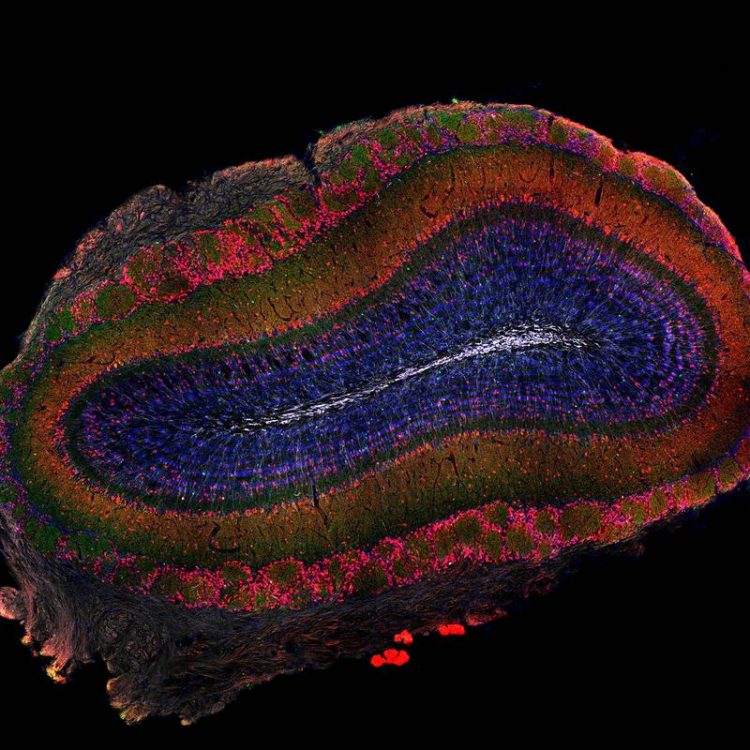Distant Brain Regions Selectively Recruit Stem Cells

New neurons (white) enter the olfactory bulb, a part of the brain that processes odor signals. University of Basel, Biozentrum
Our brain generates new neurons throughout life. A diversity of stimuli promotes stem cells in their niche to form neurons that migrate to their place of action. In an animal model Prof. Fiona Doetsch’s team at the Biozentrum of the University of Basel has now been able to show that feeding-related neurons in the hypothalamus, a brain control center for many physiological functions, stimulate a distinct type of stem cell to proliferate and mature into specific nerve cells in response to feeding.
Stem cells make neurons important for olfaction
Stem cells reside in only a few areas of the brain. The largest reservoir is the subventricular zone, where quiescent stem cells lie closely packed together. Signals from the environment can trigger stem cells to start dividing. The stem cells in the subventricular zone supply the olfactory bulb with neurons.
In rodents, almost 100,000 new neurons migrate from the stem cell niche to the olfactory bulb each day. Olfactory stimuli reaching the nose are processed in the olfactory bulb and the information is then sent to other brain regions. The closely interwoven network of diverse olfactory bulb neurons is important for distinguishing odors.
Stem cell activation over long distances
Each stem cell has its own identity, depending on its location in the subventricular zone. While new neurons are continuously generated, whether niche signals act to control different pools of stem cells is unknown.
“We have uncovered a novel long-distance and regionalized connection in the brain between the hypothalamus and the subventricular zone, and show that physiological states such as hunger and satiety can regulate the recruitment of specific pools of stem cells and in turn the formation of certain neuron subtypes in the olfactory bulb,” explains Doetsch.
When the animals fasted, the activity of the nerve cells in the hypothalamus decreased and with it also the rate of proliferation in the targeted stem cell population. This returns to normal levels when the animals feed again. The division of stem cells can be controlled by changing the activity of feeding-related neurons.
The researchers reported further that the targeted stem cell subpopulation gives rise to deep granule cells in the olfactory bulb, which may provide a substrate for adaptive responses to the environment. The results of the study raise the exciting possibility that neural circuits from diverse brain regions can regulate different pools of stem cells in response to various stimuli and states.
Original source
Alex Paul, Zayna Chaker and Fiona Doetsch
Hypothalamic regulation of distinct adult neural stem cells and neurogenesis
Science (2017), doi: 10.1126/science.aal3839
Further information
Prof. Dr. Fiona Doetsch, University of Basel, Biozentrum, Tel. +41 61 207 22 30, email: fiona.doetsch@unibas.ch
Dr. Katrin Bühler, University of Basel, Biozentrum, Kommunikation, Tel. +41 61 207 09 74, email: katrin.buehler@unibas.ch
https://www.unibas.ch/en/News-Events/News/Uni-Research/Distant-brain-regions-sel…
Media Contact
All latest news from the category: Life Sciences and Chemistry
Articles and reports from the Life Sciences and chemistry area deal with applied and basic research into modern biology, chemistry and human medicine.
Valuable information can be found on a range of life sciences fields including bacteriology, biochemistry, bionics, bioinformatics, biophysics, biotechnology, genetics, geobotany, human biology, marine biology, microbiology, molecular biology, cellular biology, zoology, bioinorganic chemistry, microchemistry and environmental chemistry.
Newest articles

Bringing bio-inspired robots to life
Nebraska researcher Eric Markvicka gets NSF CAREER Award to pursue manufacture of novel materials for soft robotics and stretchable electronics. Engineers are increasingly eager to develop robots that mimic the…

Bella moths use poison to attract mates
Scientists are closer to finding out how. Pyrrolizidine alkaloids are as bitter and toxic as they are hard to pronounce. They’re produced by several different types of plants and are…

AI tool creates ‘synthetic’ images of cells
…for enhanced microscopy analysis. Observing individual cells through microscopes can reveal a range of important cell biological phenomena that frequently play a role in human diseases, but the process of…





















